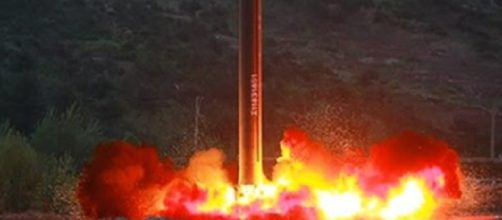Both American and South Korea’s defense officials confirmed on Saturday that the Hwasong-12 missile which North Korea launched on May 14 successfully re-entered the Earth’s atmosphere. It is considered a significant breakthrough because Seoul doubted Pyongyang’s claim on the missile’s technological features.
At the Sunday launch, the liquid-fueled missile reached 1,312 miles and traveled 489 miles before it broke into the Air Defense Identification Zone of Japan and splashed down in the Sea of Japan. After the event, Moon San Gyun, the spokesman of the Defense Ministry of South Korea, said that North Korea is unlikely to have a re-entry technology that could return a warhead back into the Earth’s atmosphere safely.
Missile took a steep parabolic route
The Telegraph cited a report from North Korea’s state media that Hwasong-12, which was capable of carrying a large-size, heavy nuclear warhead to a U.S. mainland target, hurdled the worst re-entry situation and hit the intended target. The route that the missile took that tested its ability to survive re-entry was a steep parabolic route.
Based on an analysis of data communication from the missile control center of Pyongyang, the missile survived 5,000 degrees Celsius and extreme vibration when it re-entered Earth’s atmosphere, Seoul officials confirmed. A similar confirmation came from Pentagon officials.
Experts noted that Hwasong-12 is an intermediate-range missile.
Their estimate is that it would take North Korea three more years before the technology can be applied to an intercontinental ballistic missile that has the capability to hit the U.S. mainland.
While North Korea is apparently moving in that direction, both Pyongyang and Washington claim to be more open to having a dialogue, but the two countries place conditions before the talks could push through. Kim In Ryong, the deputy UN ambassador of North Korea, said talks with the U.S. must be preceded by Washington rolling back its hostile policy toward the communist country.
Strike group in the Sea of Japan extends deployment
Although North Korea was the laughing stock of the world because of nine failed missile tests, the May 14 launch just presented proof that scientists from North Korea have gained expertise in long-range missile guidance and control capabilities.
Several underground tests by Pyongyang also showed the country has nuclear weapons.
In response to the successful re-entry of Hwasong-12 into Earth’s atmosphere, Washington extended the deployment of the USS Carl Vinson and the strike group in the Sea of Japan. The fleet was initially scheduled to leave the Korean peninsula region after another aircraft carrier, the USS Ronald Reagan, completes its refit at the American naval based in Yokosuka, Japan.


